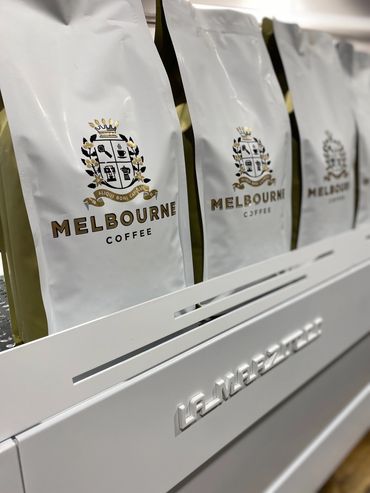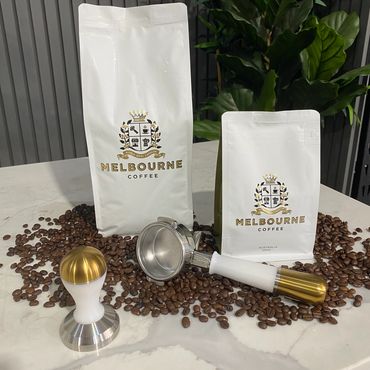Signed in as:
filler@godaddy.com
Signed in as:
filler@godaddy.com

Melbourne Coffee Australia 's premium quality 100% Arabica beans have been ethically sourced and roasted to perfection creating a specialty blend of rich, warm flavours and aromas that are distinctive of Melbourne's world renowned coffee culture.
The Melbourne Coffee Australia logo is based on the city of Melbourne coat of arms . The crown is encrusted with gold coffee beans and the four quarters of the shield displaying iconic coffee symbols,. The shield is embraced by two garlands of coffee tree branches, flowers and the fruit ('cherries'). The scroll bellow the arms reads, 'Aliqui Boni Capulus' , which translates as 'Some Good Coffee.'

Melbourne Coffee Australia's premium quality beans have been carefully blended and expertly roasted to exude the flavour and aromas of dark chocolate, warm caramel, buttery hazelnuts and dark stone fruit. The coffee is also suitable to have black or with a variety of different milk bases.

Melbourne is renowned for its vibrant coffee culture and it is intrinsically entwined with the rich and colourful history of the city.
It was with the advent of the temperance movement that arrived in Australia in the 1830's that coffee became a popular beverage.
The temperance movement, which sought to curb the drinking of alcohol, started in the United States and United Kingdom in the 1820s. Temperance societies sought to educate the public on the dangers of alcohol consumption, and their members campaigned for the enforcement of ‘dry’ suburbs and six o’clock closing for pubs.
One of the effects of the temperance movement was the introduction of coffee and tea palaces, which aimed to compete with pubs and hotels, providing a social and community atmosphere without alcohol. By the 1880's Melbourne had more than fifty coffee palaces. In 1888, one such palace was built on Collins Street, The Federal Hotel and Coffee Palace (pictured) . It was an enormous four storey architectural marvel constructed in the Second Empire style. The hotel was world class in it's grandiosity and scale with 370 guest rooms and a penthouse suite located in the tower. It became a social hub in Melbourne, and the coffee culture started to evolve.
In 1890, the Baring Crisis led to Australian bank crashes and coffee palaces found themselves struggling. Alcohol returned to the scene, but the taste for coffee remained. The 1930's saw the introduction of the espresso. Prior to that all coffee was percolated and it was when the first espresso machines arrived that coffee really flourished.
The end of the Second World War gave rise to the adoption of European coffee culture in Melbourne. The influx of European migrants over the next 50 or so years shaped the city’s thriving cultural, food and arts scene. After World War II, the arrival of Italian immigrants shaped the coffee culture of inner-city suburbs like Carlton, Brunswick, Collingwood, Fitzroy, Richmond and North Melbourne. By the 1990s, Melbourne was the coffee capital of Australia.
Today, cafe culture is celebrated Australia-wide, and particularly in Melbourne. Like the grand coffee palaces of the 19th century, today’s Melbourne cafes are still social and community hubs, where people of all walks of life unite with one common purpose – "Aliqui Boni Capulus", Some Good Coffee!
A born and bred true Melburnian, Susie McLean is the Founder and Managing Director of Melbourne Coffee Australia.
Susie was raised by her Italian, coffee loving parents who would regularly source the best cafés in Melbourne for the perfect brew. Some of her earliest memories are sitting up on a barstool at the Melbourne institution, Pellegrini's sipping caffè e latte long before 'babyccino's' became a thing.
With a life long coffee obsession and great love for her home town, Susie was drawn to create a brand that was succinctly 'Melbourne' in both presentation and flavour.
"With Melbourne in my heart and coffee in my blood, I was inspired to create a distinctive blend of the finest beans that are perfectly roasted to encapsulate the deep rich flavours and world-renowned coffee culture that is unique to our great city. After multiple coffee cupping sessions and literally thousands of cups of coffee, I selected a taste profile of dark chocolate, hazelnuts, caramel and dark stone fruit. There is also a twist of boysenberry, my favourite fruit , for a hint of tartness".










Melbourne Coffee Australia
We use cookies to analyze website traffic and optimize your website experience. By accepting our use of cookies, your data will be aggregated with all other user data.